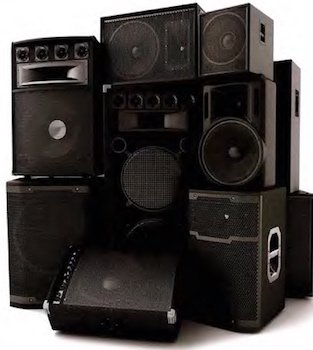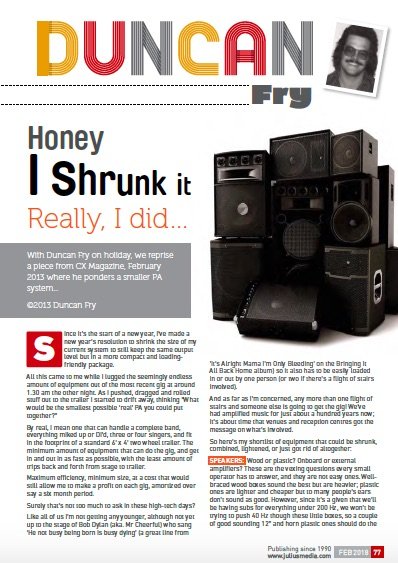News
29 Mar 2018
Honey I Shrunk It- I really Did

Subscribe to CX E-News
REGULARS
Honey I Shrunk It – I really Did
We reprise a piece from CX Magazine, February 2013 where Duncan Fry ponders a smaller PA system…
Since it’s the start of a new year, I’ve made a new year’s resolution to shrink the size of my current system to still keep the same output level but in a more compact and loading-friendly package.
All this came to me while I lugged the seemingly endless amount of equipment out of the most recent gig at around 1.30 am the other night. As I pushed, dragged and rolled stuff out to the trailer I started to drift away, thinking “What would be the smallest possible ‘real’ PA you could put together?”
By real, I mean one that can handle a complete band, everything miked up or DI’d, three or four singers, and fit in the footprint of a standard 6’ x 4’ two wheel trailer. The minimum amount of equipment that can do the gig, and get in and out in as fast as possible, with the least amount of trips back and forth from stage to trailer.
Maximum efficiency, minimum size, at a cost that would still allow me to make a profit on each gig, amortized over say a six month period.
Surely that’s not too much to ask in these high-tech days?
Like all of us I’m not getting any young er, although not yet up to the stage of Bob Dylan (aka. Mr Cheerful) who sang ‘He not busy being born is busy dying’ (a great line from ’It’s Alright Mama I’m Only Bleeding’ on the Bringing It All Back Home album) so it also has to be easily loaded in or out by one person (or two if there’s a flight of stairs involved).
And as far as I’m concerned, any more than one flight of stairs and someone else is going to get the gig! We’ve had amplified music for just about a hundred years now; it’s about time that venues and reception centres got the message on what’s involved. So here’s my shortlist of equipment that could be shrunk, combined, lightened, or just got rid of altogether:
SPEAKERS
Wood or plastic? Onboard or external amplifiers? These are the vexing questions every small operator has to answer, and they are not easy ones. Well-braced wood boxes sound the best but are heavier; plastic ones are lighter and cheaper but to many people’s ears don’t sound as good.
However, since it’s a given that we’ll be having subs for everything under 200 Hz, we won’t be trying to push 40 Hz though these little boxes, so a couple of good sounding 12” and horn plastic ones should do the trick. Ones with on board lightweight digital amplifier; if possible, so there will be no hernia-provoking amp rack to lug around.
SUBS
And speaking of hernia-provokers, subs can often be the largest/heaviest thing in the trailer, so as long as we accept that, we can work with it. We need subs because every PA system gets a paradigm shift in quality with some good sounding subs, rather than trying to squeeze some low frequencies out of boxes that were never designed for reproducing them. If they’ve got the amplifier inside, well that’s great. But if they haven’t, why not strap an amp onto the top of one or screw a little 2RU rack onto the top of one so they can travel around together?
Subs are too heavy to carry, so they need to have wheels or wheel dollies, so let’s get as much wheeled into the gig in one go as possible. At the moment I can fit both subs and an amp on a wheel dolly, so I don’t see much room for improvement there. But I am planning to put a two channel amp inside one of them, and a tethered linking cable inside the other.
MIXER
Digital or Analog? Everyone mixing can come to grips with any analog desk. But digital mixers are a runaway train that is rattling into the station at breakneck speed. Can’t stop it so we might as well embrace it.
Since the mixer is mainly operated by me it’s worthwhile learning a common one inside out. Something like one of the new Yamahas, or the PreSonus, or Julius’ favourite dig ital mixer, the new Behringer X32. This one looks like being the game-changer for digital. I suspect that in the future its launch will be seen as being the tipping point for the change from analog to digital.
The trickle-down effect, with pricing diving from astronomical down to economical, means that digital mixers, with masses of onboard EQ, effects, dynamics control, and more, will suddenly be everywhere. They will lessen the amount of outboard gear I’ll need, if nothing else! If only they all worked the same. Sigh.
AMPLIFIERS
Unless you’re heavily committed to two channel amps, why not get a high-powered four channel one? That’ll give you Left and Right boxes and two subs, in one amp. Or if your Front of House boxes are self powered, the same amp will give you enough power to drive four bitchin’ monitor sends! And four separate monitor sends are probably more than enough to keep track of through the night.
MONITORS
I’ve already got some very small monitors that have kept singers happy for a couple of years now, with no complaints at all. All they do is vocals, with maybe a little bit of instruments mixed in if necessary. Any guitarist who rolls up with a Line 6 Pod or similar gadget instead of an amplifier deserves what he gets, which in this case will be sharing a monitor send with the drummer!
And, if I can get a good price on a couple more powered 12” and horn boxes, that will mean they can double as extra FOH if needed for big rooms, or as more monitors for bigger bands.
MULTICORE
I’ve got one, but usually it only comes out for corporate gigs that are happy to pay the extra whack that I charge for it. For the sort of function I normally work at, side of stage is fine. Paranoid function managers freak out enough when you wheel in the subs, let alone take up space in their immaculately prepared ballroom with a mixer and long black cable that everyone might trip over!
But hang on a minute – many digital mixers can be remotely controlled with an iPad and wifi. Suddenly I can sit on a chair anywhere in the room and control a mixer that’s parked at the side of the stage. No multicore, digital or analog, needed … as long as my iPad battery doesn’t go flat! The first time I saw it done I was very impressed – even more so than when I sent and received a fax from my laptop twenty five years ago!
LIGHTING
Not really part of sound, but having the house lights on all night just doesn’t cut it for atmosphere! It’s an essential item for making the production look good, and I can charge for it accordingly. Longtime readers will be pleased to know that my semi-legendary Par 43 lights (made from Nescafe cans) have been pensioned off and replaced by four Par 64 LED cans, with built-in DMX control. All plugged together, they run on a medium chase all night. Sweeet! No lighting trees, to save space; the subs have poles that run to the top boxes, which have T-bars on top of them and two lights clamped to each of them.
WHEELS
It goes without saying that everything should have wheels or a wheel dolly. We’re only born with one back and need to look after it. But a three wheel ‘walking up stairs’ trolley is worth every cent it costs, and will soon pay for itself with all the money you charge for the ‘extra loader’ you had to hire (ho ho) to get up the stairs!
If anyone has their own ideas for their own Amazing Affordable Shrinking System, then let me know at dunkworld@gmail.com
©2013 Duncan Fry
TIMES HAVE CHANGED
Reading this, Julius is amazed how just five years have brought quantum steps. Starting with the higher powered, lighter and cheaper self powered speaker systems we’ve tested in Gearbox recently.
DSP science is now so good that lesser components are tweaked exactly and the sum of the parts makes a much nicer system. We’re seeing speaker packages at well under 2 grand delivering significantly more output, sounding much sweeter, and weighing at least a third less than five years ago. And that extends to the subs, some of which are easily hauled by one average musician.
At the mixer, we’re using iPad and even iPhones with many of the new generation rack mixer that has nothing other than inputs and outputs on board. These are costing UNDER $1,000!
Multicore? Pfft, gone. Effects? Inside the rack mixer, nothing external required! The one constant over five years is the microphone where oldies are goodies, and where wireless is now operating on new frequencies but still fairly similar in performance.
Plus in-ear prices have come down too. A decent small PA system that caters to a hundred people will fit in an SUV and cost well under 10 grand. That’s progress. – Julius
This article appeared in the print edition of CX Magazine February 2018, pp.77-78. CX Magazine is Australia and New Zealand’s only publication dedicated to entertainment technology news and issues. Read all editions for free or search our archive www.cxnetwork.com.au
Subscribe
Published monthly since 1991, our famous AV industry magazine is free for download or pay for print. Subscribers also receive CX News, our free weekly email with the latest industry news and jobs.







